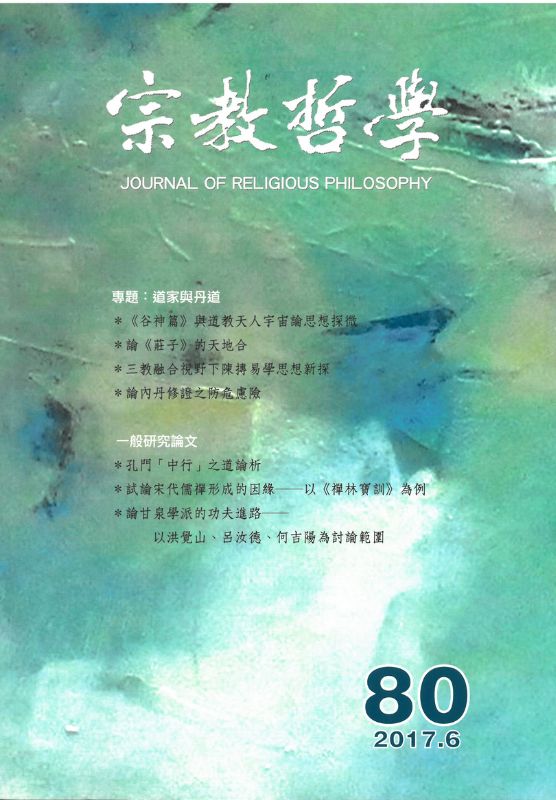道教宇宙論思想在元代閩人林轅所撰《谷神篇》中有獨特的系統闡發,以往學術界關注不夠。原始宇宙從無到有,在特定情況下產生元氣,所謂「曠劫霾翳,搏聚之內,含凝一點之水質也,孕於其間,如筐載卵,自底而生,斯有矣」。元氣剛產生時,就象一粒黍米、一粒水珠,內白外黑,由陰陽二氣制約,是一種雲氣彌漫物質。陰靜陽動,內陰向外擴散,外陽向內凝結,構成陰陽二氣的吸引和排斥的交相作用,「混質而成樸,積小而為大」,不斷聚積變化,「外陰愈摶,內陽愈凝,結成混沌」,由陰陽二氣相互作用最終形成氣團,是為原始宇宙混沌狀態。「混沌未破之時,大只百里也」,後來混沌破開不斷膨脹,形成天地、星辰、山川,「天高而愈遠,地卑而愈厚,上有積而愈巍。」其闡發的宇宙演化理論類似西方十八世紀的星雲說,其內蘊的宇宙演化思想在當時是十分先進的,乃是道教天學宇宙論的的一種經典表述。

第80期
2017年6月
| 論文 | 作者 | 頁碼 |
|---|---|---|
《谷神篇》與道教天人宇宙論思想探微摘要 | 蓋建民 Jianmin GAI | 001-008 |
The Unity of Heaven and Earth in the Zhuangzi摘要My scholarly approach is to consider and treat the inner chapters of the Zhuangzi as an integral text regardless of whether its composition is the result of many hands. I treat this in much the same fashion as Western biblical scholars study the Western bible for its meaning, whether or not it actually came into being over many years and was the result of the work of multiple authorship. It is my opinion that such an approach is more appropriate to the eminent status of the text of the Zhuangzi in the traditional, Chinese cultural canon, to its philosophical and spiritual value as a testament to the idea of the union of heaven and earth in the Chinese cultural tradition, and to its actual functioning as a working guidebook to the understanding of how to achieve a practical expansion of the spiritual dimension of human experience. In essence, I will demonstrate that a proper academic, textual analysis of this seminal work is crucial to the understanding of how it functions as a document designed to explain, illustrate and point the way to spiritual freedom. What I would like to present is the argument that the attempt to achieve the union of heaven and earth is indeed the main theme of the Zhuangzi. My argument is that the inner chapters are a literary and philosophical model of the cosmic unity of heaven and earth. My method of showing this is to show the developmental nature of the inner chapters. I begin by arguing that the myth of K'un transforming itself into P'eng with which Zhuangzi commences his work prefigures the main theme of the Zhuangzi which is that of spiritual transformation. The unity and integrity of the text is shown by a close examination of the chapters which follow. The chapters form a developmental sequence. As the inner chapters develop, we are treated to a progression of "monster" types from the gentle and honorable form of the crippled military commander through physically crippled Shu to No-lips of triple deformity. Of Shu it is said, how much better if Shu, who is physically crippled, had crippled virtue. Then, as a philosophical development, Zhuangzi presents the madman whose conventional virtue is indeed crippled. Each character dialectically progresses, allowing the mind of the reader to expand with the progression of each monstrous character, until the mind of the reader can achieve the mental freedom that it longs for. Just as the pheasant longs to be free of its cage, so does the mind of the reader long for freedom from its cage of concepts. The mind is gradually prepared by the progressive development of the monster forms until it can break free of its conventional concepts to achieve the unity of heaven and earth. Each monstrous character shows itself in turn to be more physically limited or monstrous or different in kind than the previous example, but nonetheless capable of achieving a transcendental freedom. This is the teaching of the Zhuangzi, that regardless of form and of physical limitation, man can achieve the unity of heaven and earth. The gallery of monsters are metaphorical role models for the reader to learn the lesson that physical limitation does not hinder one from reaching heavenly unity, but the proper understanding of physical limitation is the key to unifying heaven and earth. The physical oddities of Zhuangzi's messengers work together to function to break down conventional value judgments and enable the reader of the text to receive their message which is the message of the achievement of transcendental freedom. | Robert Elliott Allinson | 009-041 |
三教融合視野下陳摶易學思想新探摘要陳摶順應晚唐以降三教融合的思想主潮,積極吸收和融攝儒佛道三家之心性理論,初步建構起以內丹學為主要內容、三教融合為主要特點的易學理論和實踐的新體系,大體奠定了宋元道教三教融合的基本格局與主要內涵。陳摶在融攝儒佛道三家思想學說中所表現出來的傳承創新、平等交流等精神也為今天中西文化的交流、對話提供了參考、借鑒。 | 李玉用 Li Yuyong | 043-055 |
論內丹修證之防危慮險-以伍柳丹法為中心的考察摘要在丹道修煉中,防危慮險是成敗的關鍵。所謂:「慮險防危,金丹之大事也」。丹道修煉古來向有『九難十魔』之說,北宗尤重煉心、煉志,煉性等『煉己』功夫。傳統上內丹修證有一套完整的操作方式與技術手段。因此明師傳道,都要特別指出用功時的種種危險,提前預防,以免生害。它的傳授需要明師具體指導和個人在修證過程中細心體會。著者基於多年修證經驗,希望能夠從修道的內在體驗出發,進而以伍柳丹法為中心對內丹防危慮險進行專題的研究,期能對內丹修證做出一種契於修道現象本來意義的闡釋。本論文以伍柳丹法為中心考察內丹修證之防危慮險,因其敘訴最為精詳透徹,論述身心變化及其效應,次第分明,其不藏私、度眾的精神為前人所未見。自明末清初以後,流傳甚廣、影響深遠,故以其為為中心考察比較諸家論述,期能對內丹修證有進一步的瞭解。並結合諸家說法融會貫通,且用現代觀點對它進行整理和研究,使它產生現代意義。 | 孫嘉鴻 Sun Chia-Hung | 057-081 |
孔門「中行」之道論析-以《論語》為中心的研究摘要與〈中庸〉以「中」為論述對象不同,「中」在《論語》是一個隱含概念,然而這並不妨礙它處處顯見「中行」之道。《論語》之「中行」以內在德性為基礎,向外延伸至處世行為,並最終落實到社會秩序的建構上。首先它推揚的內在德性具有「中行」特徵,這根源於「剛毅木訥」之仁性上。在「內向性」價值影響下,它雖主張「文質彬彬」「德學並重」之理想範式,但在「文勝質」的現實中又呈現寧質勿文、以德攝學的理解性折衷。此外,《論語》以「中節」的工夫論實現外向行世的「中行」。當「中節」能因應環境隨時「節中」,便達「時中」境界。孔子之「時中」無可無不可,但實以「義」為則,此即將處世的「中行」統攝於內在仁性的「中行」。為矯禮制「文勝質」之過,孔子突顯「禮質」,主張寧質勿文之折衷,從而將「禮之本」統攝於仁上。而以仁為本的中正之禮,亦對人間秩序予以「中節」。 | 蔡智力 Cai Zhi-li | 083-116 |
試論宋代儒禪形成的因緣-以《禪林寶訓》為例摘要從東漢格義佛教將印度佛教文化帶入中國文化場域,就明顯的經歷一連串的交流對話、相互詰難,到取其優點作為借鏡,以融入或發展自身的新思想,最後三教合一或三教融合成了明清以來的傳統。從佛教自身來看這個變化過程,宋代是一個關鍵時代,佛教承續之前的三教詮說,又面臨政權變化及新儒家的挑戰,回應的過程使得佛教與儒家有更趨進的現象,這在禪宗有明顯表現,也是本論想要探討的地方。《禪林寶訓》是大慧宗杲及竹庵士珪禪師編輯二宋期間高僧大德之嘉言懿行錄,後淨善禪師再重輯,而流傳至今。此書中可見二宋重要禪師對當時禪宗現象的反思言語。本文以此書為本,在簡述佛教歷來的三教互動言說後,主要論述宋代禪師所行而形成的儒禪現象,主要探討形成的內外因緣及運用的實例,並先定義為何儒禪,以為三教交流史中提供一個明證與佛教轉折點。 | 許文筆 Hsu Wen-pi | 117-155 |
論甘泉學派的功夫進路-以洪覺山、呂汝德、何吉陽為討論範圍摘要本論文所要討論的主題,為洪覺山工夫論與其同門的功夫進路之分析,洪覺山本身為甘泉學派的大成者,受明代大儒湛甘泉稱讚為得其真傳者,其工夫論在明儒學案的說明中是以「知幾」為主,也就是發揮本體的自覺力量為主要修法,此為甘泉學派之中上層的工夫論進路。但是甘泉學派的工夫論,也強調對於習心的對治,故也有安立以「知止」為宗的工夫,也就是從定力的培養入手成就的工夫,此法的成就者為何吉陽,第三種便是以發揮氣質變化力為主的工夫論,也就是呂汝德的「變化氣質」之工夫,此三種修行方法皆是從湛甘泉的本體工夫中所生,兼顧了對於本體「自覺義」與「自由義」,也具備了對於「習心的對治義」,所以方能成為一套完備的工夫論,故本文便是以洪覺山為主,以其他二人為輔,進行對於甘泉學派工夫進路的討論。 | 黃泊凱 Huang Po-kai | 157-175 |





